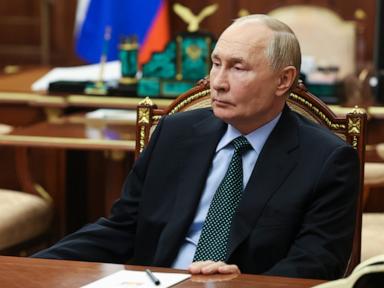Has Biden's 'just enough' strategy pushed Putin to the brink of nuclear war?

President Biden’s "just enough" strategy on Ukraine — one that would provide the weapons it needed to defend itself but not what it needed to win — is contributing directly to the worst-case scenario the White House envisioned: nuclear escalation.
Bob Woodward wrote in his book "War" that Russia’s nuclear arsenal likely deterred the White House team from fully enabling Ukraine to take the fight to Russia. He called nuclear weapons "the silent shadow present in all their deliberations.”
The Biden administration chose the least intrusive strategy — to weaken Russia by letting it drown in a conflict of its own making. Without directly threatening the existence of Putin’s regime, this would allow the U.S. to honor its security assurance obligations to Ukraine under the 1994 Budapest Memorandum, for having given up its nuclear weapons after the collapse of the Soviet Union.
Or so the thinking went. But it did not work out that way.
To validate this "silent shadow," then-Chairman of the Joint Chiefs of Staff Gen. Mark Milley asked his counterpart in the Kremlin, Gen. Valery Gerasimov, “under what conditions would you use nuclear weapons?”
Gerasimov’s response solidified Biden’s deep-seated anxiety: “If there’s an attack on Russia that threatens the stability of the regime — condition one. Second, is if a foreign power attacks Russia with a weapon of mass destruction — so that’s chemical, biological or nuclear. Third, Russia reserves the right to use tactical nuclear weapons in the event of catastrophic battlefield loss.”
It was the third condition — the catastrophic battlefield loss — that cemented his decision. There would be no Yorktown moment for Ukraine; no decisive battlefield victory — though Ukraine’s invasion of the Russian Kursk Oblast in August 2024, 30 months into the war, does seem to have fulfilled Gerasimov’s first condition.
Biden attempted to deter Putin from attacking Ukraine by multiple means. He sent his CIA Director, William Burns, to present Putin a letter “crafted carefully by the NSC in collaboration with the intelligence agencies to send the message “we know” without disclosing everything or how they knew it.”
The same intelligence being presented to Putin by Burns was being shared with NATO partners by Secretary of State Antony Blinken and Secretary of Defense Lloyd Austin to garner support. In addition, severe economic sanctions were put into place, designed to “cut off Russia's government from western financing” and target “Russia's elite and their family members.”
But as an invasion became more imminent, the White House may have been willing to "allow" a minor incursion — one that would permit Russia to seize disputed terrain in the Donbas region — to appease Putin and avoid a war.
That may have been the basis for Biden’s Freudian slip during a White House press conference held on Jan. 19, 2022. He told reporters, “I think what you’re going to see is that Russia will be held accountable if it invades. And it depends on what it does. It’s one thing if it’s a minor incursion and then we end up having a fight about what to do and not do, et cetera.”
That comment may have sent Putin a mixed message, thus green lighting his "special military operation."
Whatever understandings or political arrangements were in play, Putin of course failed to honor them. Given an inch, he took a mile and launched his invasion of Ukraine with upwards of 190,000 troops coming from Belarus, Russia and Crimea on Feb. 24, 2022.
One thing Putin is not is inconsistent. His words are meaningless, but his actions are consistent. He will say what he believes his adversaries want to hear, then act upon their naivete.
Someone forgot to tell Ukrainian President Volodymyr Zelensky, who turned down an offer from the U.S. to be evacuated from Kyiv, then famously told the world, “The fight is here; I need ammunition, not a ride.”
The White House gave Zelensky and his generals the ammunition they requested, and to everyone’s astonishment, they were able to repulse the invasion.
Now, 33 months into the war, Putin has amassed over 732,350 casualties, turned to his arsenals of evil — Iran and North Korea — for munitions, ballistic missiles, and drones, and embedded over 11,000 North Korean troops into his formations in the Kursk Oblast, and possibly the Donbas as well.
Biden’s intentions were admirable, but he got played. In September 2014, Putin said he could “take control of Ukraine’s capital city [Kyiv] in as little as two weeks.” In February 2022 he tried and failed.
The White House’s management of the war from the Oval Office has been about as effective as Nixon’s during the Vietnam War. The defensive strategy has resulted in the destruction of Ukrainian population centers, energy infrastructure and the deaths of thousands of civilians. And although the intent has been to avoid a nuclear confrontation with Russia, that is exactly the trajectory this war is on.
Or at least what Putin wants the White House to believe.
After Biden authorized to Ukraine to strike targets in the Kursk Oblast with ATACMS, Putin has publicly lowered the threshold for Russia’s use of nuclear weapons on Nov. 19. Then he took another step up the escalation ladder on Nov. 21, firing a hypersonic intermediate-range ballistic missile at the Ukrainian city of Dnipro.
Enter Rep. Michael Waltz (R-Fla.), President-elect Trump’s choice for national security adviser, and the Trump administration. On Fox News Sunday, he asked “How do we restore deterrence and how do we bring peace?” He also expressed concern “about the escalation and where it’s all going.”
Three very difficult tasks lie ahead — deterrence, peace and escalation avoidance. Trump 2.0 must remain vigilant, for Putin’s track record is clear. As much as Waltz and Trump may want to negotiate an end to the war, they would be wise to listen to Sen. Mike Rounds (R-S.D.), who said, “As much as I would like to believe we can negotiate with a tyrant [Putin], I suspect we may be deceiving ourselves … do you think he’s gonna stop?”
More "just enough," however, is not the solution. Deterrence, strategic messaging and naivety failed the Biden administration. Deterrence is achieved through strength — not by compromise with a tyrant. Trump’s best hand may be his unpredictability, which may be the best deterrent that leads to peace.
Above all, though, as we celebrate another Thanksgiving, the Trump administration should take to heart the words of President Ronald Reagan: "Let us ask ourselves, ‘What kind of people do we think we are?’ And let us answer, ‘Free people, worthy of freedom and determined not only to remain so but to help others gain their freedom as well.'"
Col. (Ret.) Jonathan Sweet served 30 years as an Army intelligence officer. Mark Toth writes on national security and foreign policy.
-

Putin Oversees Nuclear Training Exercises at Delicate Moment for Ukraine War
World - The New York Times - October 29 -
Austin says Putin lowering the nuclear threshold is 'dangerous behavior'
Top stories - NBC News - November 20 -

Putin lowers the threshold for using his nuclear arsenal after Biden's arms decision for Ukraine
World - ABC News - November 19 -

Putin lowers threshold for Russian nuclear weapons use after Biden's Ukraine missile decision
Politics - The Hill - November 19 -

Putin sends nuclear warning to West
Politics - The Hill - November 19 -

How serious are Putin's nuclear threats?
Top stories - BBC News - November 19 -

Nato says new Russian missile won’t deter support for Ukraine – live updates
World - The Guardian - 6 days ago
More from The Hill
-

Russian strike on Ukrainian energy grid leaves more than 1M without power
Politics - The Hill - 36 minutes ago -

What to expect under Trump’s new FCC
Politics - The Hill - 37 minutes ago -

Haberman suggests Trump-Musk partnership 'could last' despite criticisms
Politics - The Hill - 1 hour ago -

Elon Musk isn't 'the media' — and he should be happy about that
Politics - The Hill - 1 hour ago -

Will mail and packages be delivered on Thanksgiving, Black Friday?
Politics - The Hill - 2 hours ago